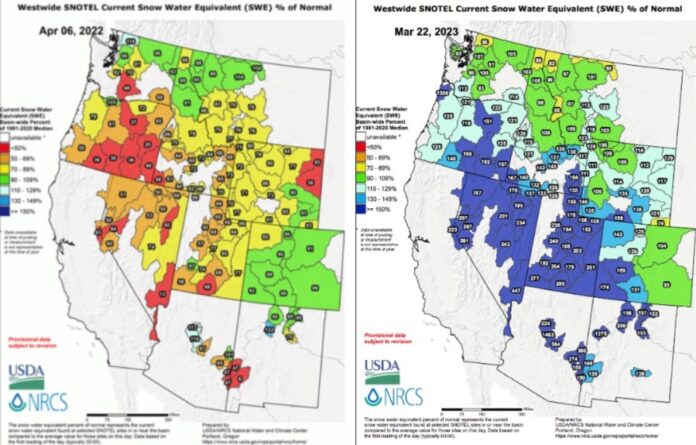Written By: Jon Easdon, Anglers Covey
Photo by Evan Jones
As an angler living in Colorado, I’m a bit of a geek when it comes to winter snowpack levels. They’re one of the best forecasting tools for river and reservoir conditions in the year to come, as higher snowpack levels result in more sustainable flows, cooler water temps, and more prolific insect hatches. And I’m happy to report that so far this year, we’re seeing some encouragingly high levels of snowpack all across the West.

Our whole region has been ravaged by drought for at least the past decade–particularly within the Colorado River basin–and while it will take years of positive snowpack to mitigate the effects, we’re already starting to see some signs of recovery, especially in California. They’re likely to set an all-time snowpack record this year, with more precipitation on the way, which will bring much-needed relief to a large swath of the state. Just look how much their situation has changed since roughly this same time last year.

Many other Western states, including Nevada, Utah, New Mexico, and even Arizona are all reporting above-average snowpack. This is pretty exciting news for the southwest, which has been plagued for several years by low water and high water temperatures. Here in Colorado we have slightly above-average snowpack, and are expecting more during March and April, our highest precipitation months. Looking north, Wyoming is currently above average, while Montana and Oregon are right about average. In La Niña years, it’s fairly typical that the Northwest does not see as much snow, but there is still time. It only takes one or two big spring storms to really ramp up the late-season snowpack.

The final deciding factor will be how quickly things start to warm up into the spring. When temperatures rise too fast, we can lose the snowpack at too rapid a pace, negatively impacting our fisheries and increasing the wildfire danger. But if we get a slow warm-up, water supplies will be stretched well into summer, creating far better conditions not only for anglers, but for everyone. If things stay on the current track, we should be looking pretty positive in terms of water this year all across the West.
Jon Easdon is Director of Services for Anglers Covey in Colorado Springs, CO.
Credit: Source link































